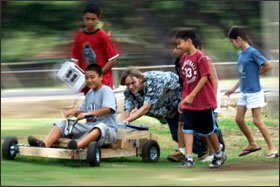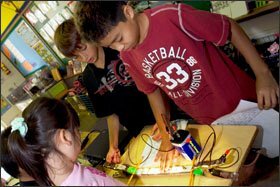When Suzanne Mulcahy began her career in education more than 25 years ago, teachers didn’t have their own mini-refrigerators, microwave ovens, or coffeemakers humming away in their classrooms.
“There was one teacher’s room with one large refrigerator,” she said.
But small appliances proliferated over time at the 790-student Kailua Intermediate School, where Ms. Mulcahy serves as principal.
So when the Hawaii Department of Education instituted a pilot program in which schools could earn back half the amount they saved in electricity over the course of a semester, Ms. Mulcahy targeted those personal convenience items.
As a result, the school’s electricity use decreased by more than 10 percent for the 2007-08 year and its power bill dropped by almost $8,000, which meant the school got back close to $4,000 to use for any purpose.
“I’ve never been an environmentalist-conservationist type of person,” Ms. Mulcahy said last month. “But if we’re supposed to be educating our students to be productive, responsible citizens, why would we not be modeling that behavior in our school?”
With the incentive program now implemented throughout the statewide school district, officials here in Hawaii are hoping that other principals will be just as diligent about cutting energy costs.
And while many on the U.S. mainland—concerned now about heating costs this winter—can’t necessarily relate to Hawaii’s balmy climate, the state’s broad approach to energy use may provide some lessons that can be applied in other states and districts.
“We’re beyond the point of turning off the lights and lowering the thermostat,” said John Musso, the executive director of the Association of School Business Officials International, based in Reston, Va. “Now it’s a bigger picture.”
Huge Expense
Nationally, energy is second only to salaries when it comes to school district spending, according to the Alliance to Save Energy, a nonprofit organization based in Washington.
School facilities nationally spent more than $12 billion on energy in 2003, the most recent data available from the federal Energy Information Administration. Those facilities accounted for about 14 percent of all the heating and cooling energy consumed by commercial, nonmall buildings that year, the agency found.
Hawaii’s geographical isolation means the state pays higher utility costs than any other because all its oil has to be shipped across the ocean. The state depends on that imported fuel for roughly 90 percent of its energy needs, according to the governor’s office.
When oil prices increase, “people on the mainland mostly see it at the pump,” said Theodore A. Peck, an energy administrator for the Hawaii Department of Business, Economic Development, and Tourism. “We see it everywhere.”
For the 178,000-student school system, annual electricity costs have climbed to almost $40 million from $22 million since 2004. One kilowatt-hour of power costs roughly 30 cents on Oahu, Hawaii’s most populous island, and more than 40 cents on Oahu’s neighboring islands. That compares with about 10 to 13 cents on the mainland.
Gov. Linda Lingle, a Republican, has made reducing the state’s heavy dependence on oil a high priority. And in January, she signed an agreement with the U.S. Department of Energy that calls for having 70 percent of the state’s power come from “clean” energy sources by 2030.
“In Hawaii, we have every source of renewable energy available,” including wind, solar, and even ocean wave power, Mr. Peck said. “We have to shift our society and our culture so it’s more sustainable.”
The push to reduce energy costs has taken on even more significance with the state now facing a budget deficit of more than $900 million over the next three years. For schools, that means the education department’s $2.1 billion budget for the 2009 fiscal year is being cut by more than $46 million, in an overall state budget of $10.8 billion in fiscal 2009.

Starting next July, schools will also be allotted lower energy-consumption targets under the incentive program, said Randolph G. Moore, the bicycle- and public-transportation-riding assistant superintendent who oversees facilities and school support services.
Currently, each school is assigned a base amount of energy consumption that takes into consideration various factors, including the size of the school and whether the building is air-conditioned. Next year, the base amount for each school will drop by 10 percent.
Schools will continue to get back from the state 50 percent of the money they save on electricity. But if they go over the base, they will have to pay half the cost from local school funds, which might include grant money to an individual school, or take it out of other money the school might have earmarked for education purposes.
Buildings with air conditioning have to turn it off by 4:30 p.m., and the use of nighttime security lights has been cut to “bare bones,” Mr. Moore said. The education department is also mandating that schools cut the number of small appliances. That’s even included removing classroom aquariums.
‘In Paradise’
Mr. Moore expects the department to derive its biggest savings from installing photovoltaic systems that convert sunlight into electricity at the same time hundreds of older school roofs on the island of Oahu are replaced.
In 2006, the state budget included $5 million to put photovoltaic roofs on one school in each of the state’s four counties.
“Schools are in session when the sun is shining,” Mr. Peck noted. “That is a happy marriage.”
The installation hasn’t started yet, in part because it took longer than expected to identify the schools that were the best candidates for the work. But the department now is hoping to install solar roofs “as quickly as the industry could do it,” Mr. Moore said.

Some schools are eager to be a part of the transformation.
“We live in paradise; we should have solar power,” said Nannette Ganotisi, a 1st grade teacher at Waikiki Elementary School, near the foot of the Diamond Head volcanic crater on Oahu.
Hawaii also enacted a law two years ago requiring that all new government buildings, including schools, be certified at the second of four levels under the Leadership in Energy and Environmental Design program of the U.S. Green Building Council, a nonprofit trade organization based in Washington. The state education department is already building to LEED specifications; nationally, there are 118 LEED-certified schools.
“What you build upfront has a huge impact on what you pay thereafter,” Mr. Moore said.
Next on the department’s list is exploring the use of wind power. But because most of the state’s schools are in populated areas concentrated here on Oahu, locating sites for windmills won’t be easy, Mr. Moore said.
Air-Conditioning Debate
Because Hawaii has just one school district, implementing any initiative is somewhat easier than it is in a typical state.
And because the education department owns and operates its schools and other buildings, unlike many other state agencies that lease space, the school system will probably have an easier time controlling energy costs than other Hawaii departments.
But the state also has some unique challenges.

To take advantage of the steady trade winds that blow in off the Pacific Ocean and can keep buildings cool, many schools were built as a collection of several small buildings instead of putting all the classrooms and offices under one roof. The state has about 250 schools, but 4,000 school buildings, which, “from an energy standpoint, is less efficient,” Mr. Moore said.
Outside on Kailua Intermediate School’s balcony—called a lanai here in Hawaii—the cross breeze is comfortable even during this time of year, which is the most humid and when the average temperature is about 85 degrees. Ms. Mulcahy said there are only a few weeks a year when students’ forearms get sweaty enough to stick to their desks or their papers.
But Kailua Intermediate is on the windward side of Oahu, near the beach, and stays cooler than many other schools.
Only 22 of the state’s schools have central air conditioning. While the state education department has no plans—and no financial means—to spend the $1.5 billion it would take to retrofit all of its schools with such systems, whether certain buildings at certain schools get air conditioning is a controversial topic for both parents and school personnel.
Computer labs and school libraries are cooled to protect books and equipment. But teachers in most classrooms open louvered blinds on their windows and let the air blow, sometimes sending students looking for rocks to hold their papers down. Others run fans.
There hasn’t been much of an outcry for air conditioning at the 350-student Waikiki Elementary School, where parents turn out by the dozens to tend an orchard of newly planted fruit trees, and some even ran an after-school enrichment class to teach children about solar power.

“We have a lot of ‘green’ parents at the school,” said Shelly Hecker, who works as an educational assistant at the school and has a daughter in its 5th grade.
Many teachers keep the lights off in their classrooms as much as possible, keeping the rooms cooler and saving electricity.
“I think the kids are more mellow with natural light,” said teacher Lydia Shigekane, who teaches kindergartners who had yet to turn 5 by Aug. 1.
But at the 2,300-student Campbell High School in Ewa Beach, considered one of the district’s hottest, parents and students have complained to the state legislature and the state board of education about classroom temperatures that can reach 90 degrees.
“You pack in a lot of kids into a 100-degree room, and that’s not too good for learning,” said Corey Rosenlee, a social studies teacher at the school.
In many communities, parents have raised money for air-conditioning units, although running them adds to a school’s kilowatt usage.
Many older schools, such as Kailua Intermediate, would also require a costly electrical upgrade to accommodate air conditioning. And while it’s likely that 10 new schools will need to be built on Oahu, Maui, and the big island of Hawaii over the next 10 years, Mr. Moore said they won’t all necessarily be air-conditioned.
Officials here are left with the challenge of making buildings and portable classrooms comfortable, which has created an opportunity for students to offer ideas.
Working with a community college, the University of Hawaii, and professional engineers, students in the construction academy at the 1,850-student Kahuku High and Intermediate School, along the North Shore of Oahu, researched ways to cool portable classrooms.
“Those things are just heat cookers” because they have flat roofs and no insulation, said Lisa DeLong, who served as the principal at the school and is now the superintendent of the Nanakuli-Waianae complex of schools.
The students’ suggestions, which include installing sun-powered vents, might even be tested at the same time the school system will be trying out designs submitted by an architectural firm for “energy neutral” portables that can be kept comfortable without electricity.
Changing Behavior
Mr. Moore also is trying to change attitudes among district personnel.
Some principals say their energy use should be allowed to increase because they’ve added after-school care or other programs. Others say the increased need for technology in the classroom drives up costs.
“We want our kids and teachers to use the computers more,” said Mitchell Otani, the principal of Kanehoe Elementary School, also on the windward side of Oahu.
Ms. Mulcahy said that when her school instituted a one-to-one computer program for teachers, she bought them all laptop computers instead of desktops because laptops use less energy, and because the teachers could take them home to work in a cooler environment in the evening. They could also charge them at home.
As one of the first schools to take part in the incentive program, Kailua Intermediate began using some practices ahead of other schools. But Carmen Craig, the vice principal, said there’s a need for continuing attention.
“Some teachers are going to need reminders” to limit the small appliances, she said. “This is not a path we’re going to stray from.”



